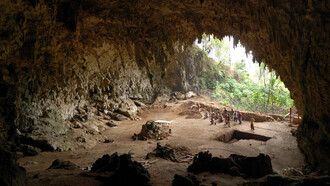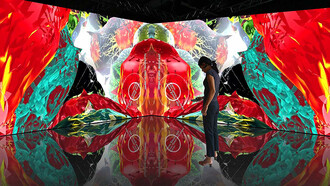(Finn Juhl)
Two towns in Tokyo wrapped in culture and the arts, Roppongi and Ueno are both commended for erecting the capital’s pillar of modernization.
The buzzing town of “six trees” or “six feudal lords” as history records it, Roppongi has maintained its elite reputation since the 1600s. The district remains as a popular abode for foreign diplomats and other foreign residents, and as a sizzling hangout for nightlife entertainment. At the same time, museums and galleries converge, especially since the development of Roppongi Hills and Tokyo Midtown, constituting a diversified hub for art and culture.
Ueno Park opened in 1876 as the first public park in Japan. The first National Industrial Exhibition was held here in 1887, and paved the road towards Japan’s era of industrial revolution. Apart from the sprawling Ueno Zoo, frequently flocked cherry blossoms, local street market, and the rich remnants of Edo neighborhood, abundant culture thrives, owing to the numerous principal museums and universities encircled around the park grounds.
Here are three major exhibitions currently running in Roppongi and Ueno.
Listen to the Sound of the Earth Turning: Our Wellbeing since the Pandemic
Our lives have hurdled dramatic changes since the Covid-19 pandemic broke out in 2020. Art expression, likewise, has transcended beyond pure visual imagery into a deeper mental and spiritual dimension. Artists have begun to address concerns about the protection of nature, nurture of well-being, and other multiple perspectives that nourish our mind and body.
Mori Art Museum in Roppongi presents Listen to the Sound of the Earth Turning: Our Wellbeing since the Pandemic until November 8. About 140 works (installations, sculptures, videos, photographs, paintings and others) by sixteen artists all over the world assess art’s powerful connection to life and human existence. They interpret changing conditions in the individual, society, and family habitually immersed in routinary daily life, nature, the metaphysical world and milestones between birth and death.
A special book of instruction art, Grapefruit (1964) by Yoko Ono, who provides the title for this exhibition, evokes the imminent potential to make our world larger through imagination.
Pollen from Hazelnut (2015-2018) by German artist Wolfgang Laib is an enormous platform installation on the floor covered with yellow hazelnut pollen. Laib studied medicine previously before becoming an artist in 1974. His profound interest in the spiritual realm has strengthened his affinity toward natural sources of life, such as pollen, beeswax and milk. The possibility to collect scarce pollen at one time projects the fragile weight of surviving on our planet.
Fumiaki Aono, a native from Sendai, illustrates Yagiyama Bridge (2019) and The SHINDEN which existed in my town—Restoration of Yagiyama Koejiyama Shrine 2000-2019 (2019), an amazing large-scale wooden collage installation made up of multifarious fragments that had been damaged or lost during the harrowing Great East Japan Earthquake of 2011.
The showcase is a soul-searching journey into the humanistic value of the self and its wholistic participation in the vast universe.
Museum Ludwig, Cologne—History of a Collection with Civic Commitments
Running through September 26 at The National Art Center, Tokyo in Roppongi, Museum Ludwig, Cologne—History of a Collection with Civic Commitments presents one of Europe’s largest collections of Pop Art, Expressionism, Cubism, Surrealism, Bauhaus, New Objectivity, contemporaneous Russian avant-garde and other forms of German modern art from Museum Ludwig Cologne. About 150 masterpieces of paintings, sculptures, videos, photographs, 3D artworks and others from the collection of the Museum Ludwig, Köln/Cologne offer a comprehensive outlook of art history from the early twentieth century to the present.
Museum Ludwig, managed by the City of Cologne, opened in 1986 with the aid of approximately 350 donated works by art historians Peter and Irene Ludwig from 1976. During this time, the overall collection, however, was drawn from the municipally operated by Wallraf-Richartz Museum. Moreover, precious works were also gifted to the museum by other private citizens and collectors, such as Josef Haufbrich, a Cologne-based lawyer and art enthusiast. Haufbrich had kept numerous Expressionist artworks in the early 1920s despite their defamation by the National Socialists. After the end of World War II, he donated a huge bulk of these seized works to the City of Cologne. Museum Ludwig has become not only an integral institution of hope and cultural identification for the German people but also a truly unique civic endeavor, symbolizing the country’s historical reunification.
Several iconic works by Picasso are on display, such as Woman with an Artichoke (1941), Woman Sleeping (1960), In the Studio (1964), and beautiful ceramic pieces.
Kandinsky’s White Stroke (1920) is a captivating piece, illustrating a greenish background with gold at the bottom and darkened corners. It emotes a peculiarly organic feeling of entering a forest, yet contrasted by various shapes and red accents.
Other notable works include Supremus No. 38 (1916) by Kazimir Malevich, a representative artist of the Russian avant-garde, who was greatly influenced by Cubism, Italian Futurism, and Suprematism, the pure abstract art of geometric forms; Pillar of Dawn (1961) by American painter Morris Louis; and Tapestry (1949 ) by German painter and photographer Wols.
Finn Juhl and Danish Chairs
Scandinavian design has always been highly acclaimed for its striking simplicity, elegance, and modern functionality. Minimalistic appearance, sleek contours, and flat colors harmonize evenly with nature. Danish design saw its popularity from the 1940s to the 1960s. Together with lamps, glass, silver and textiles, Danish furniture is equated with superior craftsmanship reflective of social values geared towards richness and happiness in everyday life.
Danish architect, interior and industrial designer Finn Juhl is regarded as the master of Nordic design. His exceptionally stunning chairs, marked by sofa-like roundish forms, smooth armrests, and slender legs, can be viewed in Finn Juhl and Danish Chairs being shown at the Tokyo Metropolitan Art Museum in Ueno till October 9.
Visitors discover the history of Danish furniture design and prominent Danish designers who have contributed tremendously to the development of furniture artisanship in Denmark.
Juhl revealed his chairs for the first time at the age of 25 at the Cabinetmakers’ Guild exhibition. At 30, he had built his own home in the north of Copenhagen, known today as Finn Juhl's House, filled with his own creations. He had been recognized internationally from the 1950s, principally for introducing Danish modern design to the U.S. He also designed the aircraft interior of Scandinavian Airlines in the 1950s and 1960s.
The Easy Chair No. 45 (1945) was launched at the 1948 Cabinetmakers’ Guild exhibition. It exemplifies practical features consisting of a brass cup holder and hooks on the sides for hanging the headrest cushion. Considered to be Juhl’s emblematic design, the Chieftain Chair (1949) deviated from traditional Danish structures with its organic shape, fine construction and walnut wood material. Juhl’s innovative vision in design later carved the Danish Modern Golden Age.
Also introduced is the furniture line of Oda Collection from Hokkaido by chair researcher Noritsugu Oda. Visitors can sit on some of the chair prototypes and experience the comfort and ease of true Danish design excellence.
Concurrently on view in the same museum until October 2 is Art & Power: From Pharaohs to Daimyōs. Masterworks from the Museum of Fine Arts, Boston. About sixty artworks from Egypt, Europe, India, China, Japan, and other regions examine their origin and historical relationship with power.















